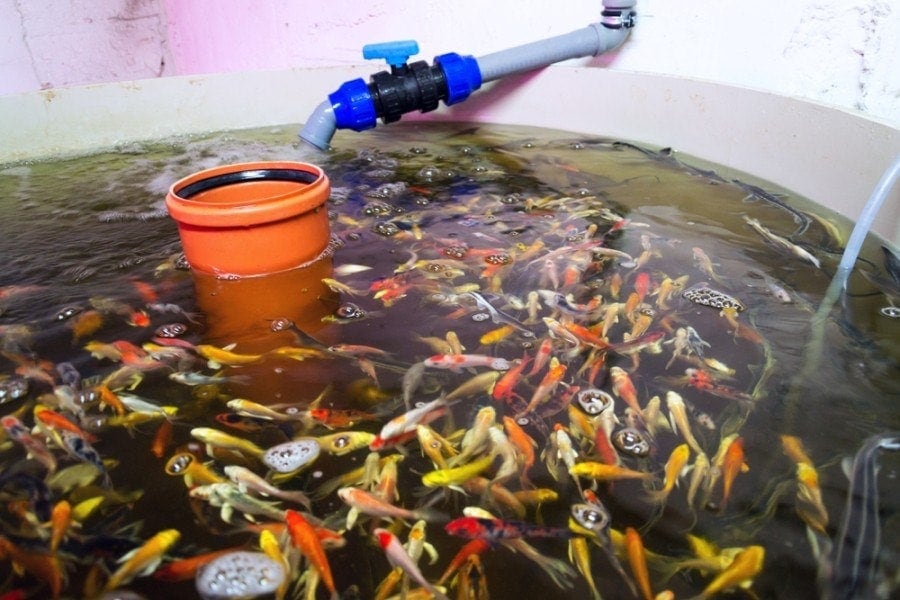Goldfish Aquaponics Complete Guide: Stocking, Feeding & Care

Updated on

Aquaponics is a new revelation that is enticing goldfish and plant lovers. This is becoming increasingly popular as you can combine the joy of two hobbies into one where both the goldfish and plants benefit from each other. Aquaponics is relatively easy and can be done by both beginners and novice goldfish keepers alike.
You see, aquaponics can be done in many ways with several different methods, plants, and goldfish species. Each aquaponics system is unique and can be tailored towards your own needs.
If you are interested in the beauty of goldfish aquaponics, then this article is right for you! We will be diving into the care aspects of goldfish aquaponics so that you can keep your goldfish and plants healthy using this simple method.
What is Goldfish Aquaponics?
Aquaponics is easy to understand. It concludes the basic setup of a pond or tub with the addition of goldfish of your choice. You are then able to add plants to the system that the goldfish will fertilize.
The goldfish produce high amounts of waste into the water column which gets absorbed through the roots of a plant. This waste is then used to aid in the growth and health of the plant with little labor from you. It is a self-sustainable plant growth method, and the fish do all the work for you.
The Scientific Explanation
If that still doesn’t make sense, there is a more scientific explanation for how this whole system works. Goldfish produce ammonia which is a product of their direct waste into the water. This ammonia is turned into nitrite and then into nitrates which is a direct by-product of ammonia. This waste is then absorbed through the roots of the plants and stored in various places where the plant will use the nutrients when it is needed. Aquaponics creates a nice symbiotic environment between the goldfish and the plants that they are fertilizing.
Aquaponics Is For Everybody!
Aquaponics uses innovative designs and simple principles that make it work for everybody. The nice thing about aquaponics is that you do not need a specific amount of space or even a definite type of plant. You can create an aquaponic environment using very little effort or even create a more complicated and dynamically strong aquaponics system.
Whatever your choice is, aquaponics can become an easy system to beat the hassle of doing water changes and excess maintenance a normal goldfish setup would require.
Why Choose Goldfish?
Goldfish are widely known as some of the messiest fish in the aquarium hobby. Goldfish are messy eaters and consume a large portion of food which results in high waste produce. When compared to other fish, goldfish are by far the best fish for the job. Not only do other fish not produce enough waste to be beneficial to plant growth, but they also do not typically thrive in aquaponic systems.
Goldfish are hardy, temperate water fish that can survive extreme water temperatures that would kill other species of fish. Goldfish can handle temperatures as low as 50°F to 93°F. This is quite a diverse temperature range that only goldfish are strong enough to endure. Since the majority of aquaponic setups are outdoors, the temperature will constantly fluctuate, and goldfish will be strong enough to handle this.
Aside from the waste and temperature aspect, goldfish are beautiful freshwater fish that look stunning in an aquaponic system. Their colors and unique finnage look best in this type of housing.

Best Goldfish Species for Aquaponics
There are plenty of different goldfish species, but not all are suited for the outdoors. This is a list of which goldfish species should be kept in either an indoor or outdoor setup.
- Comets
- Common
- Koi
- Fantails
- Shubunkins
- Jinkins
These fish do great outdoors. They also seem to be the hardiest and adaptive out of all the goldfish species. Koi are not a species of goldfish, but they are a close relative. These goldfish do best in fluctuating outdoor temperatures and have higher disease resistance.
- Blackmoor
- Telescope eye
- Veiltail goldfish
- Orandas
- Ryukins
- Lionhead goldfish
- Ranchu goldfish
- Celestial eye goldfish
- Pearscales
- Pompom
These goldfish have rounder bodies and have a difficult time getting around. They are also not as tolerant to low temperatures, and this can cause issues in outdoor ponds.
Caring for Goldfish in an Aquaponic System
There is minimal labor involved in caring for your goldfish in aquaponics, and most of the labor can be quite fun!
Feeding
Your job is to ensure that your goldfish are being fed properly in the aquaponic system. Choosing high-quality food will result in a healthier goldfish that will produce healthy and frequent waste for the plants. The goldfish should be fed a varied diet rich in both protein and plant matter as they are omnivores. A good commercial sinking pellet combined with supplements like bloodworms, mosquito larvae, tubifex worms, or freeze-dried shrimps. Your goldfish should also be fed human vegetables like deshelled-peas, cucumber, blanched lettuce, and zucchini. By feeding lots of plant matter, your goldfish will be able to pass waste more efficiently.

Water changes
This only applies to when you first start an aquaponic system as the plants will be small and must still adapt to the new environment which means they will not be absorbing waste as efficiently. Only a small water change of approximately 20% to 40%. This will limit the amount of ammonia that could potentially harm the goldfish and even burn the plant’s roots.
This can be done by a simple bucket water change. If you want to be environmentally savvy, you could even water the garden with this water instead of disposing of it down the drain. Aquarium water can be beneficial to house plants, outdoor trees, and even grass.
Don’t worry, you will not have to do water changes for very long! As the aquaponic system matures, the plants will take care of maintaining good water quality.
Health Checks
You should regularly inspect the goldfish in the system to ensure they have no signs of disease or injuries. If you do notice an issue with some of the goldfish, you can set up a small tank or plastic tote to administrate treatment. Never directly add medication into the aquaponic system as it will harm the plants.
Stocking your Aquaponic Pond or Tank
Getting the stocking right is key to a successful aquaponics system. By following this stocking guideline, you are guaranteed to have a good system on your hands.
- 100 gallons or less: 4 to 6 small goldfish
- 100 to 125 gallons: 6 to 8 goldfish
- 125 to 150 gallons: 8 to 10 goldfish
- 150 to 200 gallons: 10 to 12 goldfish
- 200 to 250 gallons: 12 to 13 goldfish
- Over 300 gallons: 15 goldfish
The more goldfish you have, the heavier the bioload will be which means many plants should be growing in the system. The more plants you have grown, the smoother the system will run. You will need strong plants to keep up with the amount of waste the goldfish produce. This will also limit the number of water changes you will have to conduct.
Best Plants for Goldfish Aquaponics
You can grow a mixture of these plants together or keep it species-specific. The plants should not be fully submerged in the water, but rather grown through plant racks where only the roots are submerged.
- Herbs
- Vegetable plants
- House plants like pothos
- Kale
- Cucumbers
- Tomatoes
- Lettuce
- Basil
- Watercress
- Swiss chard
- Cauliflower
- Mint
- Strawberries
- Spinach
- Bok choi
- Wheatgrass
- Parsley
- Radish
- Carrots
- Peas

Conclusion
Starting a goldfish aquaponics system can be fun. If you plan to grow plants that are for eating purposes, every plant and its produce is edible for human and animal consumption. Ensure that the water is dechlorinated and fully cycled (using the nitrogen cycle) before you place your goldfish in. Once the aquaponics system has been established, you can reap the benefits of healthy goldfish and fast-growing, healthy plants. This system can last for years and works well for its purpose.
Featured Image Credit: tanakornsar, Shutterstock











